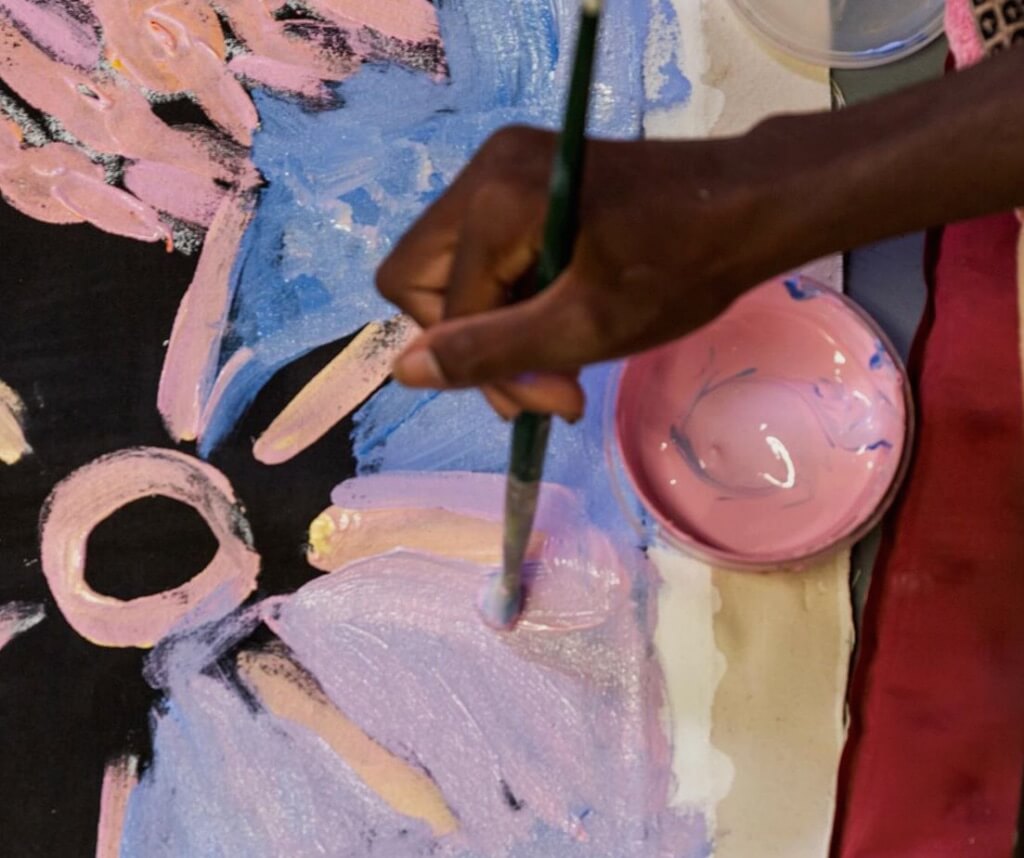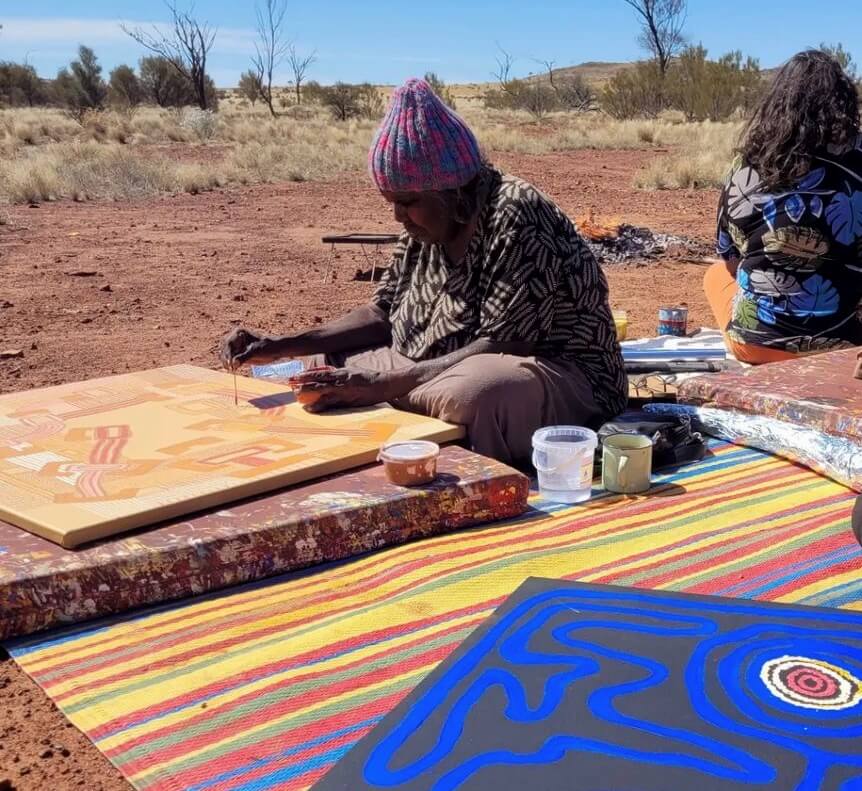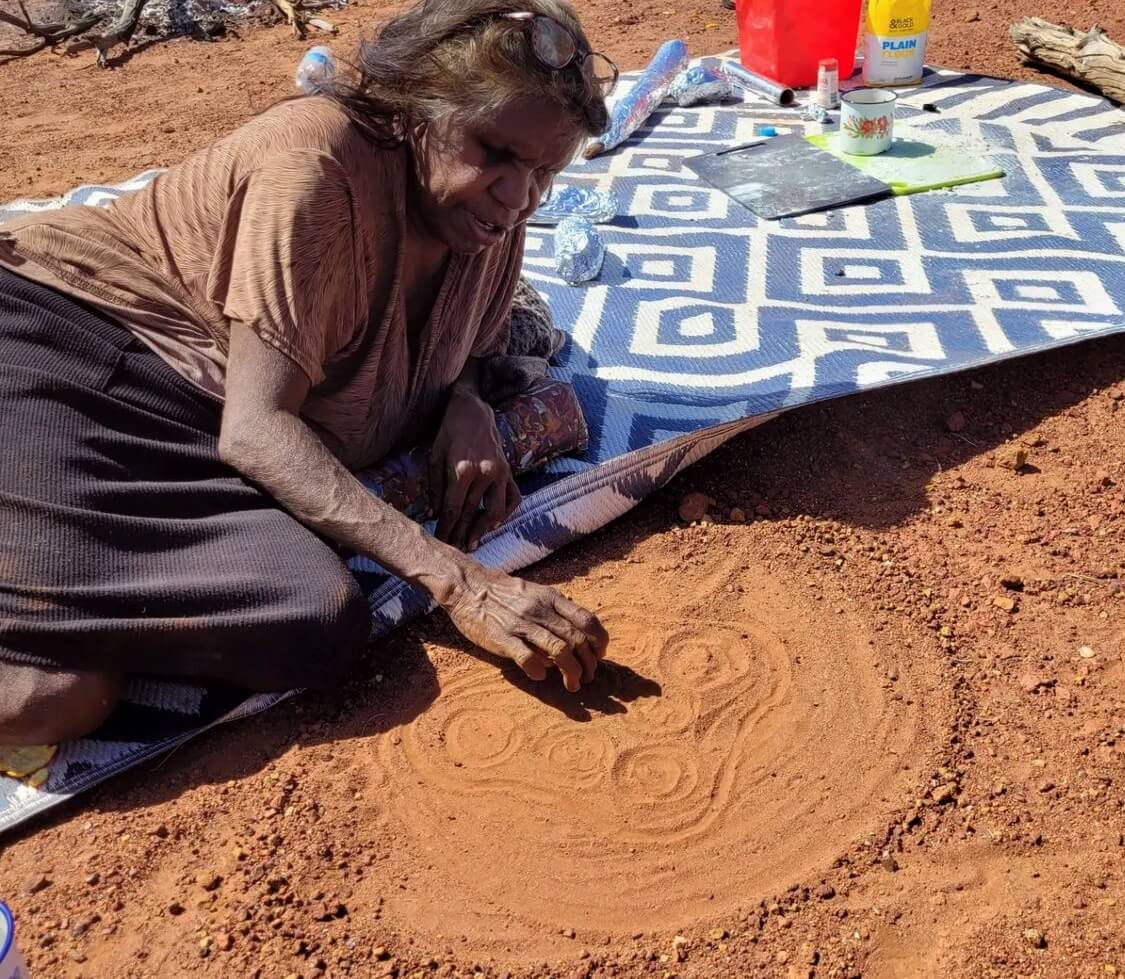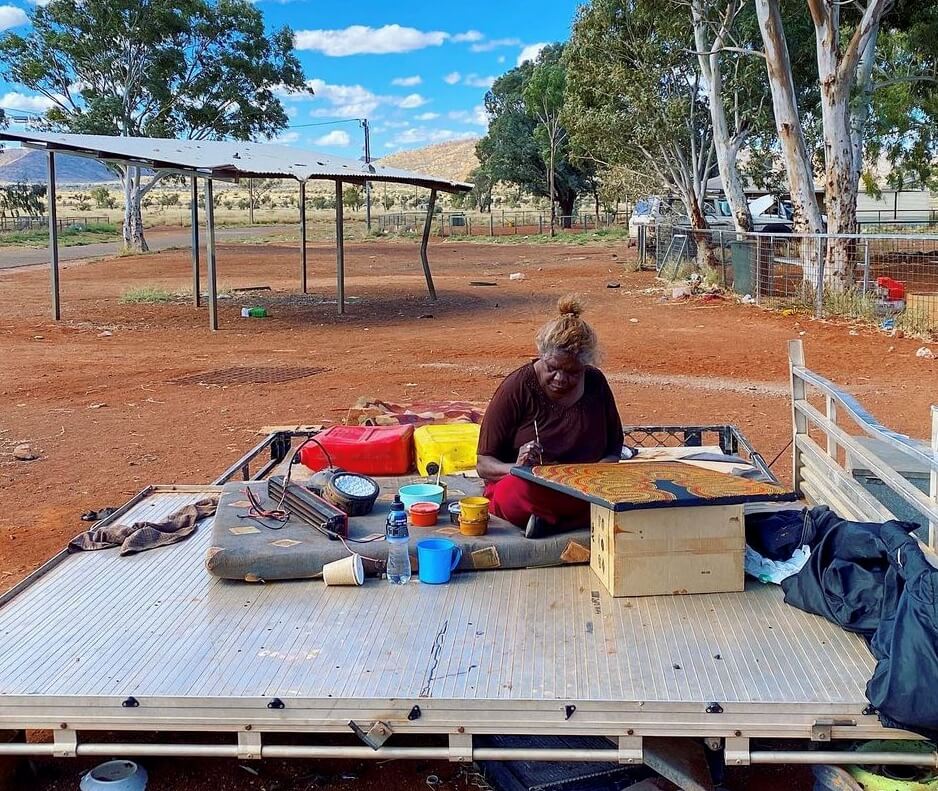Desert Dreamings: Inside Ninuku Arts, Where Ancient Meets Contemporary
Nestled within the picturesque Tomkinson Ranges of South Australia's Anangu Pitjantjatjara Yankunytjatjara (APY) Lands, near the borders of Western Australia and Northern Territory, Ninuku Arts is a place where creativity and storytelling meet, and artists congregate to pass on Tjukurpa (stories) for generations to come.
Established in 2006, Ninuku Arts serves the remote communities of Kalka and Pipalyatjara, home to around 250 people. We sat down with Georgie Gengos, the Art Centre Manager at Ninuku Arts, to learn what it's like to work at this extraordinary place.


Life at Ninuku
Can you walk us through a typical day at Ninuku Arts? What sights, sounds, or moments stand out as you move between Kalka and Pipalyatjara?
The majority of the artists live in Pipalyatjara. It's between two mountain ranges. When you wake up here, the sun peeps over and lights up one of the ranges in Western Australia about 12 km away. At the moment it's really hot, even in the morning. It's 35 degrees, and then it's been getting up to about 45, 47, 48 during the day.
The Arts Centre is located 12 km away from us. As the crow flies, it's just probably two kms, but there's that mountain range in between us. At about nine o'clock in the morning, the studio coordinator Faith, picks up about 10 of the artists who live in Pipalyatjara and takes them over to Kalka.
I'm usually already there and it's first stop cup of tea. All of the artists will then begin painting. They usually paint until about two or three o'clock in the afternoon unless there's a workshop for glass or tjanpi (grass weaving).
At the moment, there's lots of brumbies (wild horses) around. For several days we had one brumby standing outside the office window. He loves getting some cool air from the air conditioner.
The Tomkinson Ranges and the APY Lands seem vast and isolated to someone overseas. What's it like to live and work in such a unique landscape, and how does it shape the art of Ninuku?
Ninuku is located in the most remote communities in the APY Lands, which is a very remote region. We are 9 or 10 hours away from the closest post office or shopping centre. This isolation does shape the art, not only because the people here have incredibly rich stories to tell, also, people are able to live really close to their country. I think the ways in which it shines through is just their connection to country and their ability to really tell the story through the canvas.
Ninuku is based in a mud-brick building that's been expanded over time. What's one quirky or unexpected feature of the space that you've come to love?
Ninuku was built in the '80s by people from around this area using local soil. The building is extremely beautiful. My favourite part about it is that it has these beautiful rounded corners all through the space. Nothing on the inside is square. It's all beautifully rounded in the mud bricks.
I guess because it was built in the '80s out of mud brick, it's quite old and can get very dusty. Over the holidays, when the Art Centre is closed for six weeks, everything needs to go into storage because it would just get caked with red dust.
The Heart of the Art Centre
Ninuku serves two small communities, Kalka and Pipalyatjara, just 14 kilometres apart. What is the connection between the two places?
The communities are quite connected because there's people from families living in both communities. There's no services in Kalka apart from the art centre, so people need to come to Pipalyatjara most days to go to the shop, the clinic, or the school. People who live in Pipalyatjara travel to Kalka to paint at the art centre.
The Bilby Dreaming, or Ninu Tjukurpa, is central to Ninuku's identity. However it isn't the central theme for a lot of the artists' work, why is that?
The Ninuku Tjukurpa is where Ninuku got its name. It's a story that extends through the region near the Arts Centre, and is about a minyma ninu (bilby woman). That minyma ninu (bilby woman) and her family were eating all the maku (witchetty grubs). There are a lot of different maku, tjilka-tjilka, punti, ngarkalya and kanturangu. She ate so much that there were only ngingirpa left (little immature ones). The wati mututa (ant men) got really angry, and they chased the bilby family, husband, wife and kids and speared them. They finished off close to Pipalyatjara at Iririiriri.
It's quite a big story, but only a few people will paint that story because only a a few artists are from this region. This is why it isn't a theme you'll see in a lot of people's paintings. They don't paint the Ninu story because it’s not theirs to paint. We have visited the Ninu site and sat underneath the tree, and talked about the different stories.
Ninuku is known for its bold colours and diverse styles within the Western Desert tradition. What's a piece or an artist that's surprised you lately, and why did it stick with you?
I'm often surprised and delighted by the work of artists, especially Margaret Donegan. Her family is from Western Australia, and her father was a really famous artist, Kunmanara Donegan. Margaret recently started painting his story. There are a few artworks from Margaret in the Japingka exhibition. They're stunning. You can see the influence of her dad's work in her paintings.
Another person who always surprises me is a young artist named Kushia Young. She is about 26. Kushia paints all the different birds from around this region. She just has an incredible way of showing the movement and emotions of the bird in her paintings. I think her work is wonderful as well.


Cultural preservation is a big part of Ninuku's mission. Can you share a time when you saw traditional knowledge passed down in a way that resonated with you?
Yes. We have many older women who paint at the Arts Centre, and the older women will bring in the younger women from their families, their daughters or their granddaughters. They'll teach them how to paint and tell them stories. They'll teach them how to make tjanpi, which is weaving. And it's wonderful to watch it be passed down that way.
If you could sit down with one of Ninuku's artists—past or present—for a cuppa and a yarn, who would it be, and what would you ask them?
Our Chairperson, Yangi Yangi Fox, is an elder in the community. She grew up around this area. Yangi Yangi is so generous with her stories. She'll often either draw them out on a piece of paper if we're at the Arts Centre or in the sand if we're out bush.
Sometimes, we go out bush and either paint or just sit around and cook kangaroo tails and chat. Yangi Yangi is always the first person to sit down with you and tell you the story of where we are. If she's painting a new story, she'll spend a lot of time making sure that we understand what's going on in the story, what the important takeaways are, and what the story is trying to teach us.
For someone overseas who's never set foot on the APY Lands, what's one thing you'd want them to understand about Ninuku Arts and its people?
The people here are generous and kind. They have a connection with their surroundings and are able to notice the smallest things that happen. They will notice a change in the direction of the wind or just the start of wind, or the way that they'll know when the rain's coming three or four days before I know. They're going to find honey ants, and they know this region and this area and the way that it works so well. That's a wonderful thing to witness.
It's not just their knowledge; it's the knowledge passed down to them for generations. They are so connected to this country and the land they live on. It's the most important thing.


